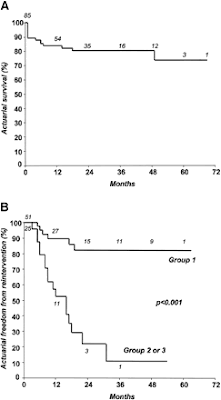(Collected from postings on Pediheart several years ago)
Overall, use of catheters and external phantoms cause large errors due to (i) inaccurate measurement, (ii) foreshortening, (iii)distortion of reference object and (iv) displacement of object of interest from isocenter (as high as 28% error in measurement of PA size).
Marker pigtail with 1 cm markers
Marker wires (expensive)
Cut piece of the markers in the pigtail - attached to patients chest
(granted, there is a "small error" ~5%, caused by magnification from Xray divergence.
AJC 2000;86(3):313-8. Compared 5 Fr pigtail or 1 cm marker catheters, Body surface markers and 1x1 cm radio-opaque grids. Most accurate method was using catheter with markers.
NIH catheter (oven Dacron) with 1 cm marker at the tip (called Cardiomarker). No balloon, therefore, internal lumen is larger than a balloon catheter of same caliber. Allows for good angiograms, good steerability and torque. The marker tip is very accurate.
Calibration ball - avoids parallax and foreshortening errors.
2-cm sphere in a pole is set to transducer height. Cine the ball (1 fps), placed on the table above patient's head and table is brought down to make the ball - isocenter in the field. This is used for calibration. This procedure is repeated for each change of tube/table position. Difference between this method and SID/Catheter computer-derived calibration in 10-20% range. Takes a little extra work but is effective and reproducible.
Daig 4Fr or 5Fr Pacel pacing wires with 10 mm radio-opaque tip - shaped to minimize distortion from camera angles. (If allowed by institution, you can sterilize and re-use).
FDA approved "nifty" device manufactured by
"The Phantom Laboratory" (Greenwich, NY) consists of a 1 cm sphere mounted on a telescoping rod that can be tilted in 3 axes. There are "scaling wings" that allow direct reading of the size of the structure. Contact: Joseph Levy at Phantom Laboratory (1-800-525-1190). Ref: Marks, LA, Marangi, D. Luks, GB. Minimizing error in the angiographic estimation of pulmonary artery size.
Ped Res 1990;27(4):22A.Calibration integral to the radiology equipment/software:
1) Automatic calibration using geometry of SID (Source - Image Distance) and PID (Part-Image Distance) to calculate the magnification. This assumes that AP and Lateral cameras are isocentered i.e. structure of interest is at the intersection of the centerline of AP an Lateral beams (Not always the case). When checked randomly with known 10 mm markers, this has been within +/- 10%.
2) The system transfers SID and FOV (Field of View) together with some other data to hemodynamic data logging system - instantly via ethernet. For each FOV, we have once calibrated the system to calculate the magnification factor for objects located at the isocenter fo the system. During the examination, one should measure the structure of interest and type that number in the "Diameter Panel" of data logging system. Later this measurement can be retrieved for comparison, etc. This method is accurate enough for on time decisions on interventional procedures. Faster than using radio-opaque markers. Assumption: the object of interest is in isocenter.
3) Siemens "Dot Cal" system: Markers are placed 6 cm apart on the image intensifiers (AP and Lateral). Place the patient in isocenter and "zero" the system to this reference point. Throughout the case, the computer keeps track of the distance from isocenter to the image intensifier, calculating the magnification on the screen. Measurements are accurate to within 5% in all 3 magnifications (9", 6" & 4") when compared with steel ball. (Warning: With Siemens Dot Cal system, once the image leavess their "HiCor" computer, this method can not be used. But, you can do it after reloading the data back into HiCor computer and do it. So, need to get all the information before deleting the file.
























